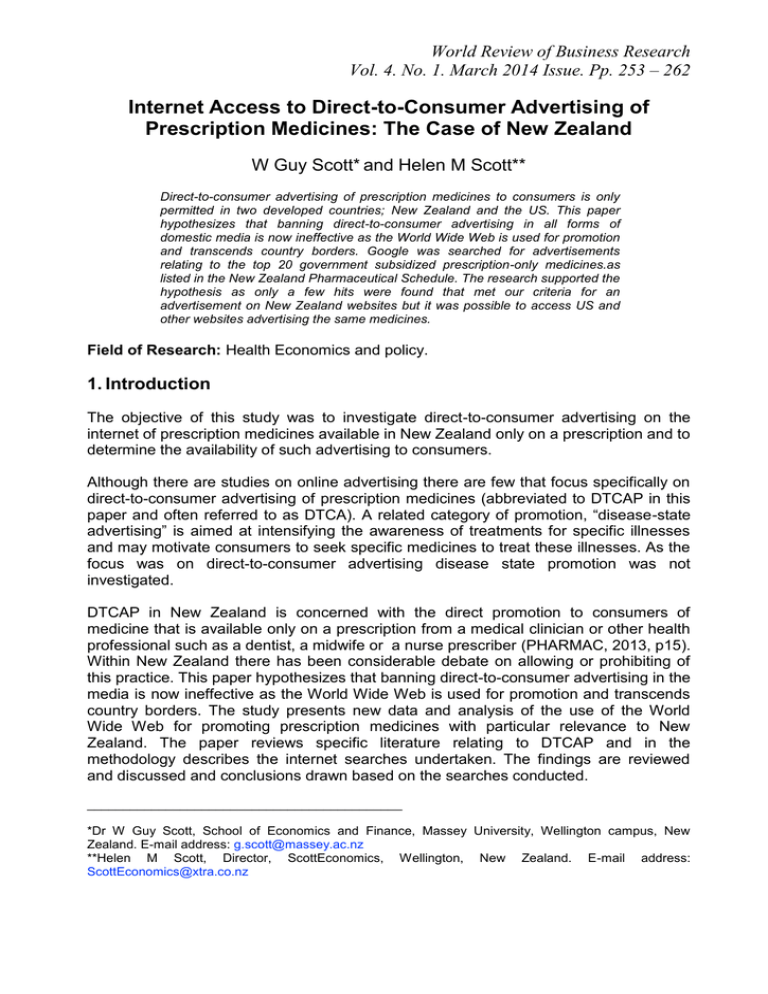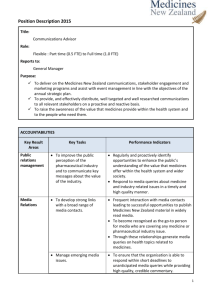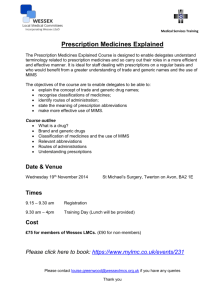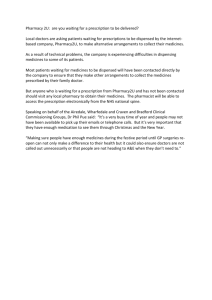Internet Access to Direct-to-Consumer Advertising of
advertisement

World Review of Business Research Vol. 4. No. 1. March 2014 Issue. Pp. 253 – 262 Internet Access to Direct-to-Consumer Advertising of Prescription Medicines: The Case of New Zealand W Guy Scott* and Helen M Scott** Direct-to-consumer advertising of prescription medicines to consumers is only permitted in two developed countries; New Zealand and the US. This paper hypothesizes that banning direct-to-consumer advertising in all forms of domestic media is now ineffective as the World Wide Web is used for promotion and transcends country borders. Google was searched for advertisements relating to the top 20 government subsidized prescription-only medicines.as listed in the New Zealand Pharmaceutical Schedule. The research supported the hypothesis as only a few hits were found that met our criteria for an advertisement on New Zealand websites but it was possible to access US and other websites advertising the same medicines. Field of Research: Health Economics and policy. 1. Introduction The objective of this study was to investigate direct-to-consumer advertising on the internet of prescription medicines available in New Zealand only on a prescription and to determine the availability of such advertising to consumers. Although there are studies on online advertising there are few that focus specifically on direct-to-consumer advertising of prescription medicines (abbreviated to DTCAP in this paper and often referred to as DTCA). A related category of promotion, “disease-state advertising” is aimed at intensifying the awareness of treatments for specific illnesses and may motivate consumers to seek specific medicines to treat these illnesses. As the focus was on direct-to-consumer advertising disease state promotion was not investigated. DTCAP in New Zealand is concerned with the direct promotion to consumers of medicine that is available only on a prescription from a medical clinician or other health professional such as a dentist, a midwife or a nurse prescriber (PHARMAC, 2013, p15). Within New Zealand there has been considerable debate on allowing or prohibiting of this practice. This paper hypothesizes that banning direct-to-consumer advertising in the media is now ineffective as the World Wide Web is used for promotion and transcends country borders. The study presents new data and analysis of the use of the World Wide Web for promoting prescription medicines with particular relevance to New Zealand. The paper reviews specific literature relating to DTCAP and in the methodology describes the internet searches undertaken. The findings are reviewed and discussed and conclusions drawn based on the searches conducted. ____________________________________________ *Dr W Guy Scott, School of Economics and Finance, Massey University, Wellington campus, New Zealand. E-mail address: g.scott@massey.ac.nz **Helen M Scott, Director, ScottEconomics, Wellington, New Zealand. E-mail address: ScottEconomics@xtra.co.nz Scott & Scott 2. Literature Review The authors have used the literature to inform the background and methodology of the study; first in a discussion on DTCAP in general, and then as it pertains to New Zealand. Much has been written about the promotion of prescription medicines to the consumer but there have been few quantitative analyses reported in the literature. Pharmaceutical company promotion to prescribers takes a number of forms; representative detailing, funding medical conferences, medical literature advertising in medical journals, free-of-charge samples and the internet (Schramm et al., 2007; Taneja, 2008; Spurling et al., 2010). Detailing has in the past been found to be more effective in driving primary demand than direct-to-consumer advertising (Marc and Sönke, 2010) but this may be changing as there is a high correlation between the number of prescriptions (but not OTC, medicines) and responsiveness to DTCA (Dieringer et al., 2011). In New Zealand promotional methods of prescription medicines is provided in Table 1. Table 1: Promotional methods used by the pharmaceutical industry in New Zealand Direct to consumer advertising Direct to clinician and pharmacist detailing/ advertising Funding medical conferences and meetings/ travel to conferences/ conference registration Public relations campaigns Journal articles/ research reports News reports/ stories Sampling Medical books Gifts Advertisements in professional journals In New Zealand a number of channels of communication are used by pharmaceutical companies to deliver DTCAP; radio, television, print media and the Internet. Consumers have access to a wide range of information sources about diseases and treatments. While it is beneficial for consumers to be fully informed before making decisions about treatment some advice provided may be detrimental to health and consumers may experience difficulty interpreting facts (Table 2). Table 2: New Zealand sources of consumer information on diseases, treatments and medicines Prescription medicine suppliers Health professionals and their specialist websites Specific health support groups and societies Health insurers Government agencies Media (print, radio, television and the internet) Family and friends Advertising relating to specific illnesses and medicines 254 Scott & Scott New Zealand and the US are the only developed countries in the world where the law permits advertising of prescription medicines direct to the consumer (Kenkel, 2009; WHO, 2009; ProCon.org, 2012 ). There has been considerable debate in New Zealand and internationally on the impact and desirability or otherwise of curbing such advertising (ProCon.org, 2012). New Zealand government approval is not required for DTCAP, although a self-regulatory system administered by suppliers operates and there are guidelines, rules and codes of practice relating to promotional content (Medicines New Zealand Incorporated, 2010; New Zealand Medicines and Medical Devices Safety Authority (Medsafe), 2011; Advertising Standards Authority, 2012). Google (Google, 2013) also have advertising approval policies for pharmaceutical drugs and monitor an extensive list of prescription medicine names. Policies differ depending upon each country’s legislation, for example, in Australia Google does not permit the use of prescription medicine names. Advertisements contravening Google’s policies may have their site/ domain suspended. It was estimated that in New Zealand in 2005 over NZ$36 million was spent on DTCAP, and on a per capita basis, pharmaceutical companies spent about NZ$9 on DTCAP compared with US$14 per capita in the US. DTCAP amounted to 5.5% of prescription medicine sales in New Zealand compared with 2.6% in the US (Kenkel, 2009). In 2000 the breakdown of New Zealand DTCAP expenditure by media category was; television 60.8%, magazines 33.0%, press 5.5%, and radio 3.6% (New Zealand Ministry of Health, 2000, p3). The Pharmaceutical Management Agency (PHARMAC) estimated that direct to consumer advertising on subsidized prescription medicines resulted in 21% of the growth in prescription medicine in 2002 (Pharmaceutical Management Agency (PHARMAC), 2002 p21). Depending upon the perspective taken, there are mixed views and many valid arguments for and against DTCAP but there is little direct quantifiable evidence available on the impact of this advertising on consumer behaviour in buying and seeking prescriptions for medicines (Harker and Harker, 2007). Little is known if this is good or bad from a health perspective (Brodie, 2008). Table 3 (based upon some of the information in a paper (Kontos and Viswanath, 2011 table 1 p144)) summarizes the various positions regarding advertising direct to the consumer. The internet in developed countries is increasingly being used as a primary source of information. In 2012, 78% of New Zealand internet users aged 15 years and over accessed the internet in the last week (Statistics New Zealand, 2013) and 78% of households had access to broadband (Commerce Commission, 2013). The internet was used by 86% of New Zealanders in 2011, 69% rated the internet as an important information source and 53% of internet users searched the Web every day (Smith, 2011). The internet was a preferred source of information on personal health” (Lemire et al., 2008). Khechine et al (Khechine et al., 2008) found that 94.2% of Canadian Englishspeaking patients with long-term diseases who used the internet sought information on treatment options and Sarasohn-Kahn (Sarasohn-Kahn, 2011) found the main reason people (36% of those surveyed) went online to seek health information was to see what other consumers said about medication or treatment. In 2013 the world’s most popular web search engines (eBizMBA, 2013b) were (1) Google, (2) bing, (3) Yahoo! Search (4) ask, (5) Aol Search, (6) MyWebSearch (7) blekko, (8) Lycros, (9) Dogpile, (10) WebCrawler, (11) Info, (12) Infospace, (13) Search, 255 Scott & Scott (14) Exite and (15) GoodSearch. The 15 most popular health sites (eBizMBA, 2013a) were (1) Yahoo! Health, (2) NIH (National Institutes of Health), (3) WebMD, (4) MedicineNet, (5) MayoClinic, (6) Drugs, (7) everydayHealth, (8) MedHelp, (9) HealthGrades, (10) RealAge, (11) WellSphere, (12) BetterMedicine, (13) RxList, (14) Healthline, and (15) Prevention. Table 3: The arguments for and against direct- to-consumer advertising of prescription medicines (DTCAP) Arguments for Arguments against Educates patients Does not educate patients Provides information that may be Requires patients to have a high degree inaccessible to patients of literacy to evaluate information Unbalanced The resources devoted to consumer directed advertising would have been better used informing the medical profession Assists patients to become more Weakens the patient-provider involved in decision-making about their relationship and is disliked by some illness and health care treatment prescribers Increases in health care costs through possible over prescribing, increased consultations and diagnostic testing Hampers treatment decisions Not all of these opinions are valid but they have been used by various interest groups to argue their cases for or against this type of advertising. 3. Methodology An advertisement on the World Wide Web for a medicine available only on prescription in New Zealand was defined by the researchers as having any one of the following features; information about coupons or subsidies for the medicine, a picture of the pack, or press release issued by the company concerned. The research focused on the presence of explicit company advertising; patient-directed Information about funding and/or choices, testimonials from patients, videos, or how to claim prescription charge refunds. The study excluded data/product sheets and links to official and medical specialist sites. As the following could be regarded as subtle forms of advertising they were excluded from the analysis; “questions to ask your GP”, links to support groups, and supply of memory aids to improve compliance in taking medication. Two Google searches were conducted and the top 10 hits in each Google search were content-analyzed. Google was chosen as this was the most commonly used search engine The first search of the top 20 prescription medicines was conducted on 17 April 2013 and the second search of company websites was undertaken on 24 April 2013. (1) The first search was of the top 20 prescription medicines ranked by New Zealand government expenditure (net of GST and rebates). These medicines represented 48% of the total government expenditure on subsidized medicines. (Pharmaceutical Management Agency (PHARMAC), 2012 p5). These top 20 medicines are mainly available through community pharmacies with the exception of the cancer therapies 256 Scott & Scott which are hospital administered. (The search was based on expenditure and not the volume of prescriptions dispensed.) The medicine (chemical name) and the condition for which it is prescribed were located in the Pharmaceutical Schedule (PHARMAC, 2013) and the specific brand or generic product/s subsidized were then searched on Google. To ensure Google focused on commercial websites the searches were prefixed by www.google.co.nz then the brand or generic product as listed in the Pharmaceutical Schedule (PHARMAC, 2013). (2) The second search investigated the websites of pharmaceutical companies that were members of Medicines New Zealand (Medicines New Zealand, 2012 p16). This search was conducted to determine the location of the domain, information supplied (product lists, patient and prescriber pages), and the presence of or links to advertisements. 4. Results/Analysis The search of the New Zealand top 20 subsidized prescription medicines ranked by government expenditure (Pharmaceutical Management Agency (PHARMAC), 2012) by both chemical name and brand or generic manufacturer found only four advertisements that met our criteria (Table 4). A blank space in the table indicates that no advertising material was present on the site. The second Google search (24 April 2013) of the websites of the seventeen members of Medicines New Zealand (Medicines New Zealand, 2012) was undertaken in two stages. The search to determine the location of the domain found that eight were global, three were Australian and six were New Zealand domain sites. Of the global sites, three only provided any further information than an address or contact details for New Zealand, and such links may have been to a combined Australia and New Zealand site. None of the Australian based sites provided anything other than contact details for New Zealand. When the New Zealand and the combined Australia & New Zealand sites (one site serving both nations) were investigated all but one provided a product list (Table 5). 257 Scott & Scott Table 4: Expenditure on the top 20 government subsidised medicines (Pharmaceutical Management Agency (PHARMAC), 2012) by NZ$ million Google search Google search5 Information Brand or found: Cost generic product 2 Medicine funding NZ$ Condition as listed in the Rank (chemical and/or 3 Million New Zealand name) medicine 1 Pharmaceutical choices Schedule4 targeted at the consumer6 1 64.5 Atorvastatin Raised Zarator cholesterol 2 44.9 Adalimumab Autoimmu Humira ne disease 3 28.1 Trastuzumab Breast Herceptin, Baxter cancer 4 22.9 Blood Diabetes CareSens, Yes for I glucose CareSens N, product diagnostic Accu-Chek test strip Performance, FreeStyle Optium 5 18.8 Imatinib Leukemia Glivec mesylate 6 18.8 Budesonide Asthma Symbicort Yes with Turbuhaler, eformoterol Vannair 7 18.3 Venlafaxine Depressio Arrown Venlafaxine, Effexor XR 8 17.2 Fluticasone Asthma Seretide, Yes with Seretide salmeterol Accuhaler 9 15.3 Rituximab Cancer Mabthera, Baxter 10 15.1 Dabigatran Blood Pradaxa clotting 11 15.0 Candesartan Heart Candestar cilexetil disease 12 14.8 Risperidone Psychosis Apo-Risperdone, Dr Reddy’s Risperidone, Ridal, Risperdal, Risperdal Consta 13 11.8 Varenicline Smoking Champix Yes tartrate cessation 14 10.9 Tiotropium COPD Spiriva 258 Scott & Scott 15 10.6 16 10.1 17 9.8 18 9.7 19 9.6 20 9.3 bromide Fluticasone Sodium valproate Etanercept Asthma Epilepsy Auto immune disease Metoprolol Heart succinate disease Erythropoietin Low blood beta cell count Bortezomib Cancer Flixotide, Flixotide Accuhaler Epilim (all forms) Enbrel Metaprolol-AFT CR NeoRecormon Velcade, Baxter 1 Top 20 Medicines by ex-manufacturer cost (ex GST and rebates) (Pharmaceutical Management Agency (PHARMAC), 2012 p5) 2 Medicine: Pharmaceuticals medicines under budgetary control by PHARMAC 3 Condition: the main use/condition for which the pharmaceutical is subsidised 4 (PHARMAC, 2013) 5 Google search: New Zealand based, 17 April 2013, www.google.co.nz product name This confined the search to New Zealand company websites under each product listed in the table above. 6 Consumer directed Information about funding and/or choices. “Yes” indicates patient directed information that may include testimonials from patients, videos, how to claim prescription charge refunds. The next stage was to determine the information supplied (product lists, patient and prescriber pages), and the presence of or links to advertisements. Two websites did not provide this information, but in some instances the remaining sites gave very little data and/or no links to official websites. If a member company had a product/s listed in the “Top 20” of the Pharmaceutical Schedule (PHARMAC, 2013) the product/s were searched on the company website (Table 5). It was found that only two products could be considered to have been advertised. New Zealand and US websites may be searched from any country by logging in to Google and typing Site:NZ or Site:US. Although the searches were conducted from New Zealand, many of the websites were international. The investigations were confined to the top 10 hits but if the thousands of potential results had been scrutinized many more advertisements featuring prescription medicines may have been found. 259 Scott & Scott Table 5: Google search 24 April 2013 of the 17 websites of Medicines New Zealand pharmaceutical company members Global (.com Australia: NZ: Website domain located in: or.net) (.com.au) (.co.nz) # pharmaceutical company members 8 3 6 Domain site with link to NZ or a 3 0 combined Australia & NZ link Information Global NZ link Australia NZ Product list on NZ or NZ link 2 6 Products, patient and/or prescriber 4 2 3 5 information on the site Advertisements Global NZ link Australia NZ Advertisement on the website 2 Advertisement for product in “Top 20” 2 Australian researchers (Gu et al., 2011) investigated 70 websites that focused on common health or medicine related topics. Their search for DTCAP advertising found 10 sites originating from New Zealand or the US. The investigation revealed some advertising embedded within disease awareness and ePharmacy web pages. They concluded that despite legislation banning DTCAP within Australia consumers were exposed to DTCAP. Our study found few consumer directed advertisements that were or had been on TV or in the print media were replicated on the internet. Some of the top 20 medicines are well established and companies may consider such medicines do not require as much advertising support as do newer medicines or treatments. However, it was noted by the researchers that some pharmaceutical companies could be said to have introduced more subtle forms of advertising reaching consumers through web-based patient support groups (for example, www.myviva.co.nz) that have no direct relationship to the company. Most of the information presented by companies was of a factual nature and related to package inserts and medicine data sheets outlining indications and contra indications for prescribing and use by patients. Some companies had links to other websites such as patient support groups, medical professional sites and New Zealand Medicines and Medical Devices Safety Authority (Medsafe). (Medsafe is an official government supported organization disseminating information in the public domain (Medsafe, 2012) performing a similar function to that of the FDA in the US). Consumers have less (imperfect) information about health and health care interventions than do healthcare providers and may have difficulty interpreting information available to them. This situation is highlighted by the posts on Facebook and YouTube that discuss the medicine but were not advertisements according to the criteria we applied to the research. This state of affairs (asymmetric information) is a serious cause of market failure in health care markets (Arrow, 1963; Stiglitz, 2000). Two situations may occur. Lack of balanced unbiased information may cause either under or over consumption of prescription medicines. If the informed demand curve is below the uninformed demand curve advertising may have caused over-consumption of prescription medicines. Strict adherence to legislation and advertising codes of practice should ensure advertisements are not false or misleading and correct for asymmetric information. 260 Scott & Scott 5. Conclusions More sites containing advertising would have been found had we extended the searches beyond the top 20 medicines ranked by government expenditure, included eParmacy sites, and encompassed more than the member pharmaceutical companies of Medicines New Zealand. In addition, “disease-state advertising” (aimed at intensifying the awareness of treatments for specific illnesses) was not a part of our study objective. Because the information on the World Wide Web is constantly changing from minute to minute a limitation of this study is that if it were to be replicated in the future different data would be discovered which may alter the conclusions of the paper. The investigation and findings support the hypothesis that banning direct-to-consumer advertising of prescription medicines in a country’s print, radio, television media and domestically domiciled websites will be ineffective if somewhere in the world such advertising is permitted and is thus available to consumers. The search results may be different if conducted at another time period or from a country other than New Zealand. References Advertising Standards Authority. 2012. Therapeutic Products Advertising Code. Wellington: Advertising Standards Authority. viewed May 2013. <http://www.asa.co.nz/code_therapeutic_products.php>. Arrow, KJ 1963. 'Uncertainty and the welfare economics of medical care'. American Economic Review, 53, 941-73 pp. Brodie, M 2008. Public Views of Direct-to-Consumer Prescription Drug Advertising. Henry J. Kaiser Family Foundation, Menlo Park. Available: www.kff.org. Dieringer, NJ, Kukkamma, L & Shorr, RI 2011. 'Self-reported responsiveness to directto-consumer drug advertising and medication use: Results of a national survey'. BMC Health Services Research, 11. Available: http://www.scopus.com/inward/record.url?eid=2-s2.080053172491&partnerID=40&md5=9d11b9861c6af2c6f015b504d8486223. eBizMBA. 2013a. Top 15 Most Popular Health Websites April 2013. eBizMBA. viewed May 2013. <http://www.ebizmba.com/articles/health-websites>. eBizMBA. 2013b. Top 15 Most Popular Search Engines | April 2013. eBizMBA. viewed May 2013. <http://www.ebizmba.com/articles/search-engines>. Google. 2013. Advertising policies Healthcare and medicines. World wide web: Google. viewed 24 April 2013. <. Gu, P, Williams, KA, Aslani, P & Chaar, BB 2011. 'Direct-to-consumer advertising of prescription medicines on the internet: An Australian consumer perspective'. Journal of Pharmacy Practice and Research, 41, 196-202 pp. Available: http://www.scopus.com/inward/record.url?eid=2-s2.080053903701&partnerID=40&md5=32b2032b9f430ec03c45d7b9f78e7617. Harker, M & Harker, D 2007. 'Direct-to-consumer advertising of prescription medicines: A systematic review of the evidence from the perspective of the consumer. '. Journal of Medical Marketing, 7, 45-55 pp. Kenkel, D 2009. 'Pushing pills to consumers'. Competition and Regulation Times, 8-9 pp. Kontos, EZ & Viswanath, K 2011. 'Cancer-related direct-to-consumer advertising: a critical review'. Nature Reviews Cancer, 11, 142-150 pp. Available: DOI 10.1038/nrc2999. 261 Scott & Scott Marc, F & Sönke, A 2010. 'Patient- or physician-oriented marketing: What drives primary demand for prescription drugs?'. Journal of Marketing Research, 47, 103-121 pp. Available: http://www.scopus.com/inward/record.url?eid=2-s2.076749150986&partnerID=40&md5=87c48ad510d86308decb6f5c51fe23d5. Medicines New Zealand 2012. Annual review 2012. Medicines New Zealand, Wellinton. Available: www.medicinesnz.co.nz. Medicines New Zealand Incorporated 2010. Code of practice edition 15. Medicines New Zealand Incorporated, Wellington. Available: http://www.medicinesnz.co.nz/codeof-practice/. Medsafe. 2012. Medsafe Website. Wellington. viewed http://www.medsafe.govt.nz/>. New Zealand Medicines and Medical Devices Safety Authority (Medsafe). 2011. Guidelines on the regulation of therapeutic products in New Zealand; Part 7 Advertising of therapeutic products; (section 2.2 Advertisements directed at the public; 2.2.1. Prescription medicines). Wellington: New Zealand Medicines and Medical Devices Safety Authority (Medsafe). viewed May 2013. <http://www.medsafe.govt.nz/regulatory/guidelines.asp>. New Zealand Ministry of Health 2000. Direct-to-consumer advertising of prescription medicines in New Zealand: a discussion paper. New Zealand Ministry of Health, Wellington, N.Z. PHARMAC 2013. 'Pharmaceutical Schedule, April 2013'. New Zealand Pharmaceutical Schedule, 20. Available: http://pharmac.govt.nz/patients/PharmaceuticalSchedule/Schedule. Pharmaceutical Management Agency (PHARMAC) 2002. Annual review 2002. Wellington. Available: http://www.pharmac.health.nz/search?search_q=annual+review&search_path=% 2Fsearch. Pharmaceutical Management Agency (PHARMAC) 2012. Annual review 2012. Wellington. Available: http://www.pharmac.govt.nz/AnnualReview. ProCon.org. 2012. Should prescription drugs be advertised directly to concerns? : Santa Monica. viewed May 2012. <http://prescriptiondrugs.Procon.org/>. Schramm, J, Andersen, M, Vach, K, Kragstrup, J, Kampmann, JP & Søndergaard, J 2007. 'Promotional methods used by representatives of drug companies: A prospective survey in general practice'. Scandinavian Journal of Primary Health Care, 25, 93-97 pp. Available: http://www.scopus.com/inward/record.url?eid=2s2.0-34248551217&partnerID=40&md5=071db4aaab23f8fbea48d77251bb5674. Spurling, GK, Mansfield, PR, Montgomery, BD, Lexchin, J, Doust, J, Othman, N & Vitry, AI 2010. 'Information from pharmaceutical companies and the quality, quantity, and cost of physicians' prescribing: A systematic review'. PLoS Medicine, 7. Available: http://www.scopus.com/inward/record.url?eid=2-s2.078149397167&partnerID=40&md5=e10bdf76aabffc7b5b4054215be26585. Stiglitz, JE 2000. Economics of the public sector. Norton, NY. Taneja, G 2008. 'Impact of Pharmaceutical Industry Promotion Mix on Doctor's Prescribing Behavior'. Asia-Pacific Business Review, Vol. IV, No. 4, pp. 82-95, October - December 2008. Available: http://ssrn.com/paper=2049738. WHO 2009. 'Direct-to-consumer advertising under fire'. Bull World Health Organ, 87, 576-7 pp. Available: DOI S0042-96862009000800009 [pii]. 262





